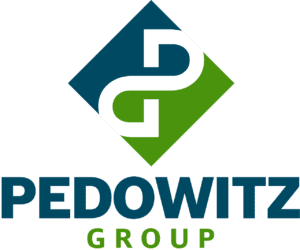Pick your best product / service. Now, put yourself in your customer’s shoes: How easy it is to get what they need from you?
That customer experience will make or break the sale … or the decision to even engage with sales in the first place.
From providing answers to Google queries to sending emails they actually want to open, every touchpoint matters. And if just one falls down, you’ve opened the door for your competition to score a closed-won opportunity at your expense.
So, how do you build a world-class customer experience? Let’s get started:
Click to jump to a section: Who’s In The Room? | Statistics | A Bad Example | What Good Looks Like | Get Started
Who Designs the Customer Experience?
If your answer is “marketing” then you’ll be wasting a lot of time!
Anyone who interacts with customers (sales, marketing, customer service, etc.) …. and any team that indirectly supports a customer’s experience (think IT or finance, for example) should have a voice in the process.
As Alan Gonsenhauser says, “The CMO should help the CEO and functional peers create and continuously improve enterprise customer focus … Ultimately, it’s the CEO’s responsibility to provide the leadership, culture, and autonomy to drive a customer-centric enterprise. He or she can delegate that responsibility to the CMO or another leader to be the key customer evangelist, but must fully support the process.”
This is a cross-functional ordeal that requires top-down support. Anything less is only setting you up to fail!
This can feel like a shift in culture … because it is. And you, as a marketer, can lead this change.
In fact, one could argue this is a fully transformative effort – and yes, you should read that linked blog right now, then come back here to continue.
CX Statistics Worth Knowing
You can read 100+ more in our list of customer experience statistics, but here are a few key ones to have in any slide deck, ready to use:
- Customer-centric companies are 60% more profitable than companies that don’t focus on customers. (SuperOffice)
- 73% of all people point to customer experience as an important factor in their purchasing decisions. (PwC)
- Companies that exceed lead and revenue goals are over twice as likely to create Personas than companies who miss these goals. (Cintell)
- Campaigns generated top-of-funnel inquiries increases by 721% when actively using personas. (Marketing Sherpa)

What Bad CX Looks Like
What happens when a customer relationship develops poorly? Let’s take a look:
The scenario
Company X – let’s call them Acme – has been marketing and selling the same way for a long time, and it’s been working well. They are the “800-pound gorilla” in their space. Half of their customers are legacy, and net-new business comes from referrals and brand-building activities like events.
They owned their market and business was strong…
…until competitors built disruptive platforms and started delivering high-touch service that’s simply better than what Acme currently offers. Acme’s customers start to leave them in favor of the quicker, more streamlined service they are getting from the competition.
As Acme’s Sales team loses more and more deals, they press Marketing for more (and better) leads. Marketing feels Sales is too old-school and mishandles the leads. Finger pointing and blame-throwing ensue… and the customer is lost in the middle.
The funnel letdown
Acme always focused its marketing and sales efforts around a traditional lead funnel.
- They see the world in terms of Marketing Leads, Sales Leads, and Opportunities.
- Sales doesn’t always value Marketing Leads, and Marketing efforts aren’t always in tune with what Sales is trying to sell.
- Execs look at the funnel metrics religiously to see how many Leads are making it through. Recently, the velocity has slowed, and more leads seem to fall through the cracks.
Naturally, Marketing is pressured to make it rain and big campaigns are planned. But like many companies, Acme doesn’t have a clue as to what’s needed to really engage customers and prospects across the buying journey. In addition, they can’t measure campaign effectiveness, which leaves much to be desired for return on investment discussions and hampers Marketing’s ability to demonstrate bottom-line impact.
Funnel results, in Acme’s case, are the metric – but it only looks at the internal perspective.
How did this happen?
Acme failed to deliver experiences its customers now expect.
Instead of delivering relevant information at the appropriate time, Acme:
- Has difficult-to-find help articles for its key services
- Enabled a chatbot for a more modern experience on its website, but it frustrates users and only provides a generic experience across the site
- Blitzes prospects with a wide swatch of emails and poorly-timed sales calls before prospects are ready for a sales interaction
- Hasn’t produced many new assets to grab visitor’s attention, and they aren’t terribly insightful. They don’t provide a new angle to their market.
Acme has failed to understand what the customer truly wants. They’ve modeled marketing and sales processes around what they consider to be a funnel.
Related: Build a chatbot that doesn’t suck
You’re familiar with this as a consumer
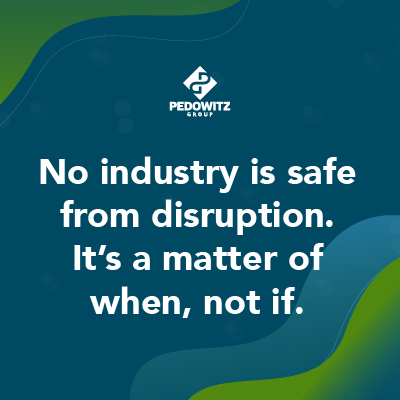
We all regularly engage with companies that have gotten too comfortable as leaders in their industries. Think Telecom and Transportation, for example:
- The Baby Bells were dominant until disruptors like mobile networks, Skype, and chat came along.
- Transportation from airlines to taxis were strong until Zoom, Uber, and the need to meet in-person diminished.
- Going on vacation? It used to be rental companies and hotels. Now, you have AirBnB, Vrbo, and so many other choices at your fingertips.
We could name many examples, but the lesson is clear – no industry leader is safe from disruption.
This is tough news for brands that have never had to build win-win customer relationships or design customer experiences that anticipate prospects’ evolving needs.
Even the biggest brands would be well-served to take a fresh look around if they want to increase profitability in the ensuing months and years!
Challenges
Getting customer-focused can be enormously difficult:
- It means integrating systems, data, and processes in order to enable customer-focused campaigns
- Instead of spraying emails, marketing must learn to nurture prospects with stage-appropriate offers based on their interactions – the right message at the right time in the right format and channel.
- Sales must learn to pick up the conversation and engage at the right time, tailoring their approach based on activity history.
All customer touchpoints become orchestrated.
Here at The Pedowitz Group, we believe this is integral to adopting scalable and sustainable revenue marketing throughout your enterprise that earns marketing as much (if not more) respect throughout the company as engineering, product, or sales.
Your CX Strategy, In 3 Steps
While a customer’s buying journey can differ significantly across different industries (finance vs. manufacturing vs. pharmaceutical, for example) … some core concepts remain constant for B2B buyers.
Here are three steps to developing your CX strategy:
- Know Your Buyer’s Persona
- Understand How They Buy
- Develop a Way to Engage Throughout Their Buying Journey
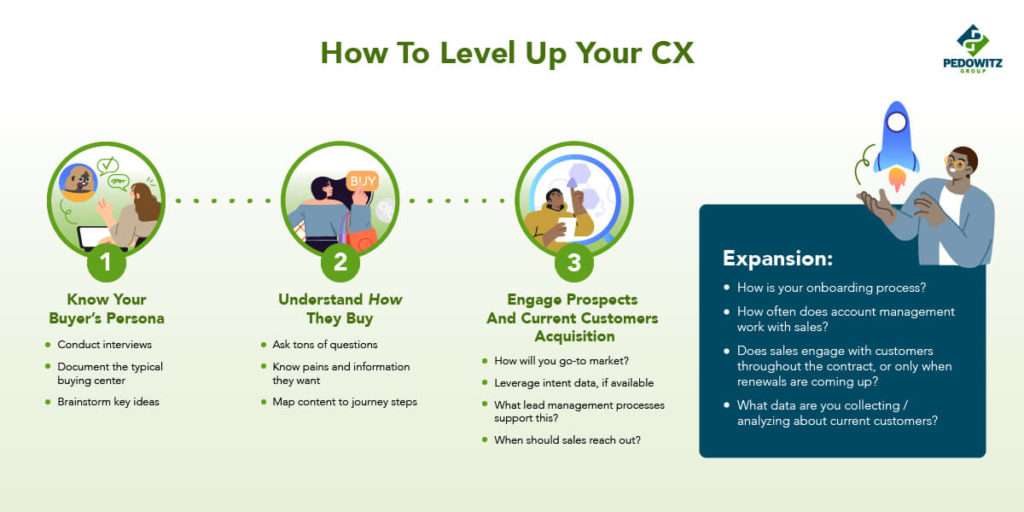
Companies like Acme, our woeful protagonist in the previous section, must refocus their efforts on the long-term versus the immediate sales need.
“But that doesn’t help my numbers now” … I hear it being shouted from the mountains already!
To be honest, you can do both (and you’ll have to if you want necessary buy-in). Here’s how, and make sure to dive more in-depth into this area in our customer journey mapping post.
1. Know Your Buyer’s Persona
Hubspot’s definition of a buyer persona still holds true: A buyer persona is a semi-fictional representation of your ideal customer based on market research and real data about your existing customers. The greater the detail, the more rounded your persona becomes.
I like to think of this process as creating a real 360-degree person that represents an essential segment of your buying center
There are some fundamental steps that need to be considered when developing a buyer persona.
Conduct Interviews
If possible, reach out to a few of your current customers and gather information from their perspective. The following is critical intel that drives future marketing strategy and ideation:
- What specific problems they needed to solve
- Why a product/service such as yours was important to them
- What made them decide to purchase from you
Along with actual customers, reach out to key members of your organization to interview as well. Get a representation of all customer-facing departments such as sales, product development, and customer service.
Understanding how each of these areas interacts with your customer is also critical to building out a persona that encompasses the entire customer journey.
Document Your Buying Center

From your customer and stakeholder interviews, it should become more clear who all is involved when it comes to purchasing your products/services. Depending on the complexity of the sale, multiple individuals may have to be consulted before a company can actually sign on the dotted line.
Along with the actual decision-maker, there are champions, influencers, as well as users and technical representatives that my need to be consulted. These individuals make up a buying center and understanding all of the significant players will ensure marketing is more strategic and personalized.
Brainstorm Key Areas
The greater the detail on areas such as demographics, behavior patterns, motivations, triggers, goals, pain points, information consumption, social and professional network, and influencers (to name a few!), the more well-rounded your personas will be.
All of these details play a role in how marketing is designed for a given persona. For example: knowing what industry associations and publications your persona is connected to could open up additional outreach opportunities that are very specific and segmented.
2. Understand How Your Customers Buy
Once you have your set of buyer personas, now it’s time to align them to your customer journey. Here at TPG, we use The Loop customer journey model that encompasses the customer acquisition and expansion stages:
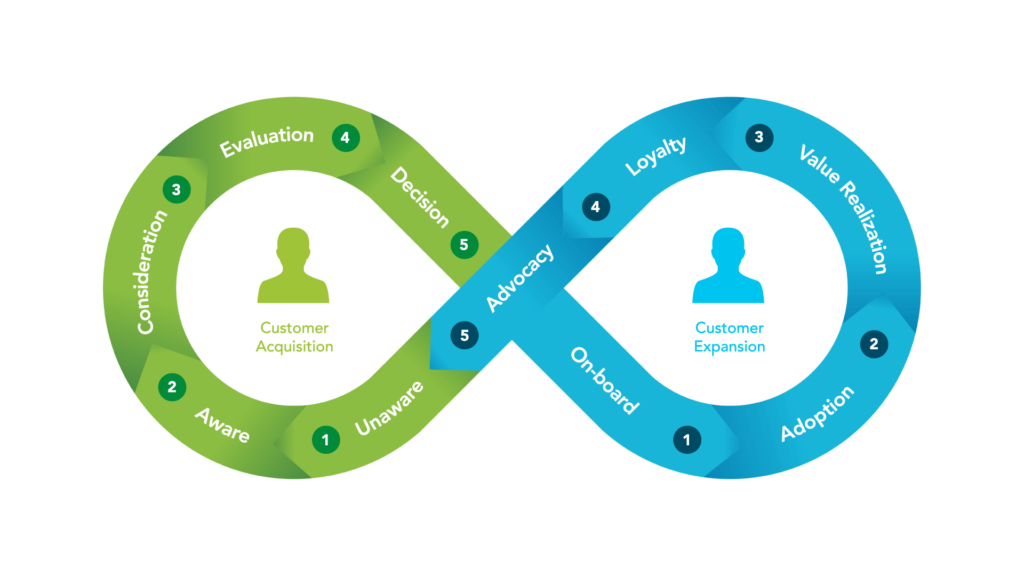
Did you notice how Acme’s problem, in our previous example, was not just net-new acquisition … but also customer retention? They’re equally important to growing the business and each process feeds into the other – thus, The Loop!
Aligning to this process requires many of those same stakeholders that you interviewed in your organization to participate. If you want to truly understand what your buyers need or are seeking at each stage of the journey, you will need representatives from all customer-facing areas to weigh in and share insights.
Related: Our lead management consulting services make this happen!
Ask ALL the questions.
To understand how your customers buys, you need to get inside their head, take a walk in their shoes. Consider coming at this from three different angles:
- Choose a product or service that you provide. Working with a specific product in mind, list out as many questions your persona has at each stage of the customer journey.
- Take an overall industry approach with questions your persona has at each stage.
- Take a specific pain point or trigger and document questions at each stage.
The idea is to create a list of multiple questions for each of your personas that align with every stage of the customer journey. Then, as you get ready to work on your content strategy, the answers to these questions will help you define ideas that will serve your buyer personas. Remember, you are the customer – word the questions as if you are asking as a customer yourself!
The confidence from knowing what your personas need at every stage of the customer journey will allow you to meet them where they are, whether they are just becoming aware they have a problem or at the stage of evaluating options for a solution.
Map content to each step – Answer the questions
Now that you have an explosion of questions at each stage of ther journey, you need to begin to become the guide for your customer and provide answers. Your content should do exactly that.
Providing content for every stage allows you to get closer to putting the right message in front of the right person at the right time. What question(s) in a given stage is someone trying to answer … and do you have an article, video, PDF, etc. to give them that answers those pain points?
Now you have your personas, the typical path(s) they take when interacting with your business, and probably a good idea of what your best content is. It’s time to put the puzzle pieces together!
For each buying stage, determine what content fits best. An explainer blog may be better for “Unaware” vs. a low-value gated PDF for “Consideration” vs. an interactive assessment for “Decision” on the left side of the loop.
On the right side, keep in mind you are targeting current (or recent) customers. What are they interested in two weeks and two months after their initial purchase with you? Are there related topics you can speak to?
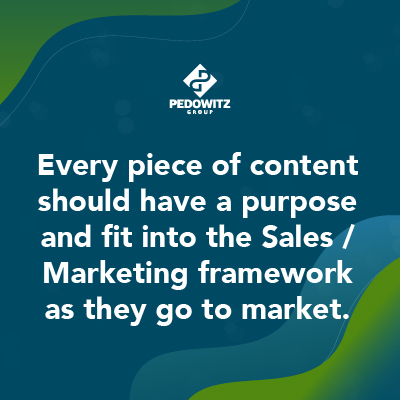
Mapping this out provides two key items:
- It gives each piece of content a specific purpose and provides a valuable framework for marketing / sales to use as they take products to market
- Gaps will be identified, whether outdated or simply missing. Now, marketing knows the highest-value assets it can produce!
Note you can have multiple pieces of content for a given stage – they may provide different insights into a similar problem, or a user may respond better to one vs. another. Don’t force it into a stage it shouldn’t be!
Map this out for each key product line / service offering (you’ll want to pick 1-2 to start with to figure out what works best for you), and then you’re ready to move onto the final step.
3. Develop A Strategy To Engage Prospects And Current Customers
- Personas? Check
- Buying Journey? Check
- Persona questions by journey stage? Check
- Content that answers each question for your personas at the right stage? CHECK!
Congratulations! You have all the tools you need to get tactical. So, let’s talk distribution.
This isn’t just digital advertising, but it covers your email nurtures, outbound sales calls, social selling… any potential touchpoint!
Split your touch points into two areas: acquisition and expansion. Consider these factors when deciding your channels and interaction for how a customer will interact with your business:
Acquisition
- How will you take your content to market, based on the buyer’s journey you’re working with?
- Using intent data, you may leverage display advertising through an ABM platform
- Finding relevant questions on places such as Quora or Reddit could be places to share your content
- What SEO opportunities are hidden in your Google Search Console data? Do you have tons of content that aren’t moving the needle and can be repurposed or deleted?
- When someone downloads a PDF or takes an assessment, what are the follow-ups? Who’s responsible for them?
- At what point should a sales team member call?
Expansion
- What does your onboarding process look like? Is it painful, or smooth?
- How do you welcome new customers?
- What ways can you make long-term customers feel special and valued?
- Do you have a referral program?
- How often do Account Managers work with Sales to find common points?
- Do your Sales team members only talk to current customers when it’s time to renew, or are they actively engaging / fostering the relationship throughout the year / contract?
- What data are you collecting about current customers (and we mean more than just “where to send the bill”)?
Knowing what channels it makes sense to leverage, and for which stages, will create a more scalable model for marketing to operate with.
Related: Develop your own multi-channel strategy with our team!
Measure Engagement Across Channels
Marketing doesn’t need to monitor every single datapoint available, but having the right KPIs allows you to build a concise, relevant story showing marketing’s successes and how they tie to revenue objectives.
Expert tip: A rookie mistake we see over and over again with KPIs is trying to measure too many things at once. Focus on a small set of KPIs, optimize and then move on. In addition, remember that not all metrics are created equal, some are meant for the boardroom and some should stay with your team for operational decision making.
Here’s some examples for stage / good metrics, but you may have others that are valued within your organization:
| Stage | Metric |
| Unaware | Impressions, Site Visits, Organic Ranks |
| Aware | Pages / Session, Videos Watched, Emails Sent |
| Consideration | Low-Value Asset Downloads, Emails Clicks |
| Evaluation | High-Value Asset Downloads, |
| Decision | Calls Booked, SQLs |
| Onboarding | Completion Rate, Time To Engagement Start |
| Adoption | Number Of Active Users, Feature Usage |
| Value Realization | Decision-Maker Engagement (Content Read, # Of Conversations, etc.) |
| Loyalty | Retention Rate, Average Renewal Value, Client Case Studies |
| Advocacy | Client Referrals, Member Of Customer Advisory Board, Google Reviews |
Ready to Get Started?
Personas, customer journeys, content, distribution…there is a lot to consider when trying to create the optimal customer experience. As you push for greater marketing impact on revenue, tactics absolutely matter … but without an overall focus on the customer’s wants (and knowing what they are), you’ll get nowhere fast.
If you nail the experience time and again, they will purchase, buy more, renew, and even advocate… a win-win relationship.
So, how do you begin taking what you have and making it even better?
- Investigate our take on the customer journey model a bit further, including key steps to excellent lead management
- Dive into mapping a customer journey
